#Trail of Tears
Explore tagged Tumblr posts
Text
donate to families in palestine and gaza. if you can’t protest, donate. if you can’t donate, post about it. reblog posts with donation sites. do the daily clicks for gaza. doing nothing is supporting genocide.
#help for palestine#palestine#palestine genocide#gaza genocide#free gaza#gaza strip#gazaunderattack#gaza#free palestine#rafah#fuck israel#support palestine#save palestine#save gaza#save rafah#help#donate if you can#donation#gofundme#fundraising#please donate#protest#palestinian genocide#palestinian lives matter#palestinian resistance#justice for palestinians#save palestinians#trail of tears#israel#israel hamas war
938 notes
·
View notes
Text
"My ancestors have already lived through an apocalypse. For us, the end of the world is 'been there, done that'.
In 1831, the world came to an end for my family--and for all the families that were part of Chahta Yakni, the Choctaw Nation. That year we were forced off our ancestral homelands and made to walk on a death march called the Trail of Tears. Thousands of our people died. We lost our homes, our way of life, even our graveyards. We lost everything--everything, that is, except the one thing they could not take from us: hope."
--We Survived the End Of The World: Lessons from Native America on Apocalypse and Hope by Steven Charleston
81 notes
·
View notes
Text















Milestone Monday
Sacred Lands, Broken Promises
On this day, January 27, 1825, the U.S. Congress sanctioned Indian Territory, which is located in what is now Oklahoma. This decision was part of the United States’ broader policy of westward expansion, driven by the belief in Manifest Destiny—the idea that the U.S. was destined to expand across the North American continent. It laid the groundwork for the Indian Removal Act, which President Andrew Jackson signed into law in 1830.
One of the most infamous outcomes of this policy was the Trail of Tears. This tragic event involved the forced relocation of Native Americans from their lands during the 1830s. The term particularly refers to the Cherokee Nation's tragic journey in 1838-1839, where thousands of Cherokee people were marched westward under harsh conditions. The journey was marked by immense suffering, including exposure to harsh weather, disease, and inadequate supplies. Estimates conclude that thousands of Native Americans died as they were uprooted from their ancestral lands to this designated territory.
The relocation and its consequences had lasting impacts on Native American communities, and it remains a significant and painful chapter in U.S. history. The era highlighted the conflicts between the U.S. government and Native American nations, as well as the broader issues of sovereignty, land rights, and cultural survival.
P. S. Sorry (not sorry), Mr. Jackson, we’re still here!
The images featured come from:
Rhymes of the States by Garrett Newkirk with drawings by Harry Fenn after sketches by the author. It was manufactured by De Vinne Press and published by Century Co. in New York in 1896. The work contains prose and verse that is intended to be entertaining and educational. However, the piece on Indian Territory is a prime example of colonial discourse.
Pushing the Bear: A Novel of the Trail of Tears is a historical novel by Diane Glancy (Cherokee). Our copy is a first edition published by Harcourt Brace (New York) in 1996. The novel tells the story of Cherokee removal and their journey along the Trail of Tears.
Songs from the Native Lands: poetry by Victoria Lena Manyarrows (Tsalagi/Eastern Cherokee), published by Nopal Press (San Francisco) in 1995. The poems featured are titled We Remember/The Trail of Tears and Unthanksgiving/We Will Not Be Invisible.
View more posts from our Native American Literature Collection.
View more Milestone Monday posts.
-- Melissa (Stockbridge-Munsee), Special Collections Library Assistant
#milestone monday#milestones#indian territory#indian removal act#american indians#native americans#indigenous americans#trail of tears#cherokee nation#manifest destiny#andrew jackson#us history#sovereignty#Rhymes of the States#Garrett Newkirk#Harry Fenn#De Vinne Press#Century co#Pushing the Bear: A Novel of the Trail of Tears#Diane Clancy#Harcourt Brace#Songs from the Native Lands: poetry#Victoria Lena Manyarrows#Nopal Press#Native American Literature Collection#Indigenous American Literature Collection
64 notes
·
View notes
Text

46 notes
·
View notes
Text
I was telling the mother and the godmother about Sinners, and as they have no desire to watch it (they agreed it sounded good, but neither of them like horror films) I was able to tell them some of the details. So they were amazed to learn about the connection between the Irish people and the Native American nations, and the Choctaw and Cherokee Nations in particular, because of the Indigenous peoples' donation to the Irish Famine relief even in the wake of the Trail of Tears; and the donations that Ireland sent to help the Hopi and Navajo tribes fight COVID. The mother especially was intrigued to learn that the sculpture of metal feathers that we sometimes drive past in Midleton, east Cork, is Kindred Spirits, commemorating the original donation.
Of course, us being us, they were then very amused to learn about the Choctaw hunters chasing a vampire to the house of a KKK couple and, after being barred from entering the house to get at him, trying to warn the racist woman pointing a gun at them and then seeing the sun is just about to set, they immediately decide Right, good luck with that, the monster fella's your problem now and get the hell out of there.
#sinners 2025#sinners spoilers#sinners 2025 spoilers#choctaw#cherokee#trail of tears#irish famine#we drive past kindred spirits whenever we're going to rosslare to get the ferry in the morning#which isn't very often but it's lovely to see the sculpture
52 notes
·
View notes
Text
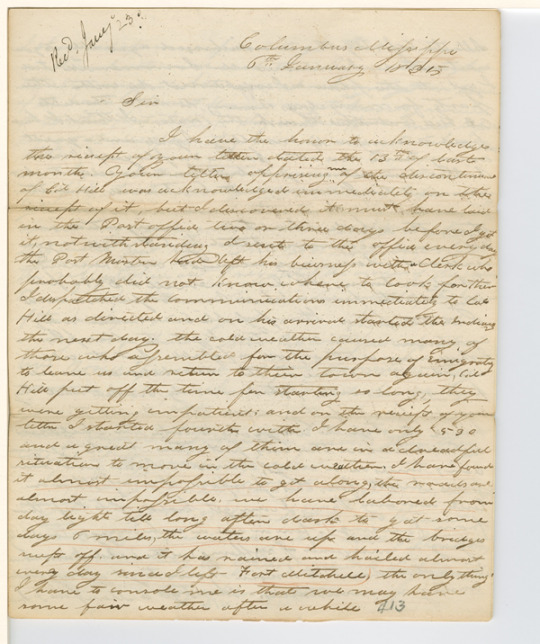
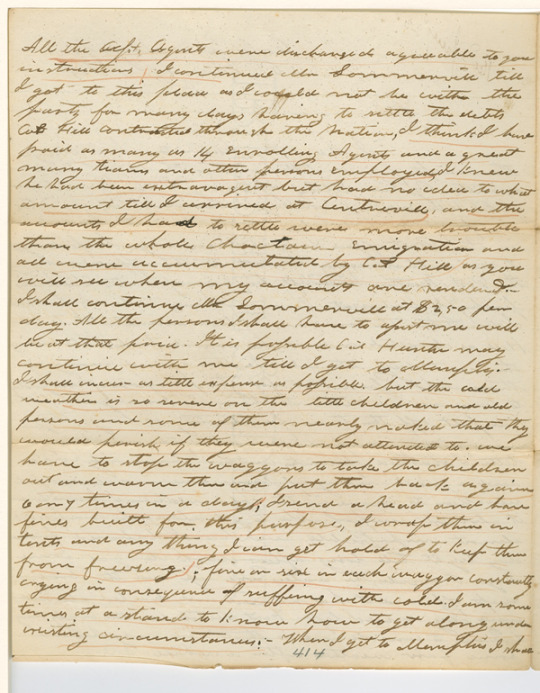
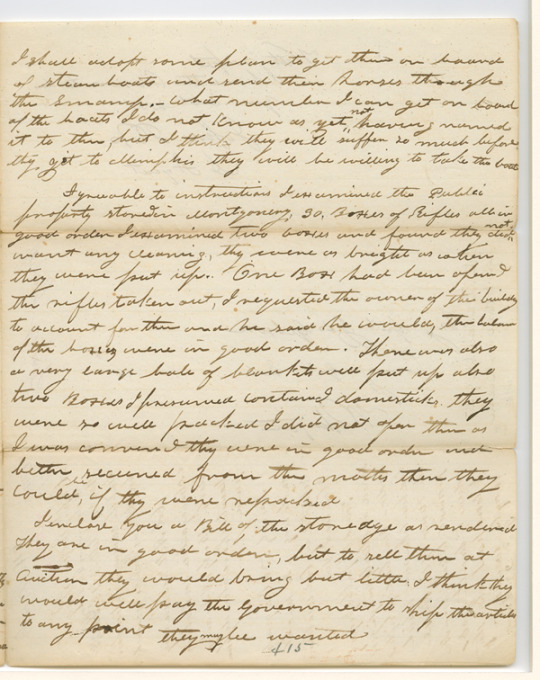
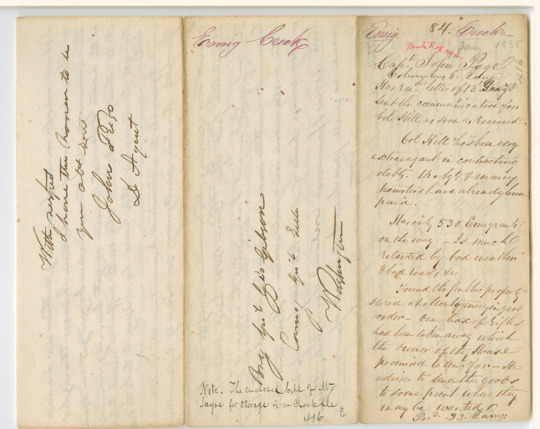
Letter from Captain John Page Regarding the Movement of 530 Creek Indians
Record Group 75: Records of the Bureau of Indian AffairsSeries: Letters ReceivedFile Unit: Narrative of Emigration in 1834 with Statement of Expenditures
Rec'd Jany 23d
Columbus Missippi [sic]
6th January 1835
Sir
I have the honor to acknowledge the receipt of your letter dated the 13th of last month. Your letter apprising me of the discontinuing of Col Hill was acknowledged immediately on the receipt of it, but I discovered it must have laid in the Post office two or three days before I got it, notwithstanding a visit to the office every day the Post Master had left his business with a clerk who probably did not know where to look for them I dispatched the communications immediately to Col Hill as directed and on his arrival started the Indians the next day. the cold weather caused many of those who assembled for the purpose of emigrating to leave us and return to their town again, Col Hill put off the time for starting so long, they were getting impatient; and on the receipt of your letter I started fourth with [forthwith]. I have only 530 and a great many of them are in dreadful situation to move in the cold weather. I have found it almost impossible to get along, the roads are almost impassible, we have labored from day light till long after dark to get some days 6 miles, the waters are up and the bridges swept off, and it has rained and hailed almost every day since I left Fort Mitchell, the only thing I have to console me is that we may have some fair weather after a while [complete transcript at link]
39 notes
·
View notes
Text
youtube
How To Erase a People
Another magnificent work by Uncivilized
24 notes
·
View notes
Text
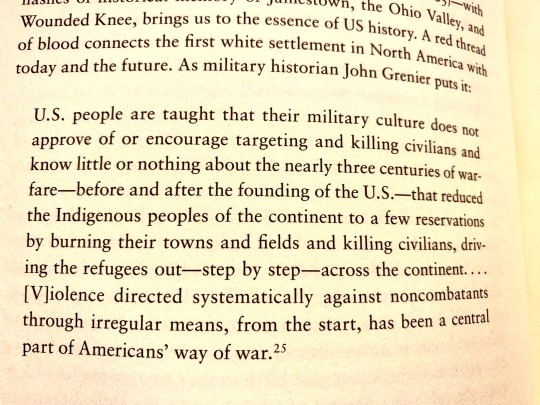
“U.S. people are taught that their military culture does not approve of or encourage targeting and killing civilians and know little or nothing about the nearly three centuries of war-fare-before and after the founding of the U.S.-that reduced the Indigenous peoples of the continent to a few reservations by burning their towns and fields and killing civilians, driving the refugees out--step by step--across the continent....Violence directed systematically against noncombatants through irregular means, from the start, has been a central part of Americans' way of war. “
Military Historian John Grenier
Excerpt from Roxanne Dunbar-Ortiz’s book:
An Indigenous People’s History of the United States
#us history#wounded knee#sand creek#trail of tears#the long walk#bear river#thanks taking#in Country#🇺🇸#land back#crazy horse#tecumseh#sitting bull#Geronimo#chief joseph#emiliano zapata#Joaquin murrieta#Pó Pay#captain Jack#war crimes#enthic cleansing#Roxanne Dunbar Ortiz#american history
283 notes
·
View notes
Text
Shannen's Native American Descent
We all know Shannen Doherty was of Irish descent through the paternal side of her family.
The Doherty / O’Doherty family is an Irish clan based in County Donegal. The O’Dohertys are named after Dochartach (c. 10th century), a member of the Cenél Conaill dynasty which in medieval Irish genealogy traced itself to Niall of the Nine Hostages. The O’Doherty clan and family name is one of the most ancient in Europe. The clan traces its pedigree through history, pre-history, and mythology to 2BC. (Source)

Shannen and her dad, John Thomas Doherty, in Ireland ca. 1996/97.
Shannen was also from English and Scottish descent through her mother Rosa Elizabeth née Wright. The red-haired Southern belle also has Native American ancestry, most concretley the Chumash people (Source), and thus has Shannen (Source).
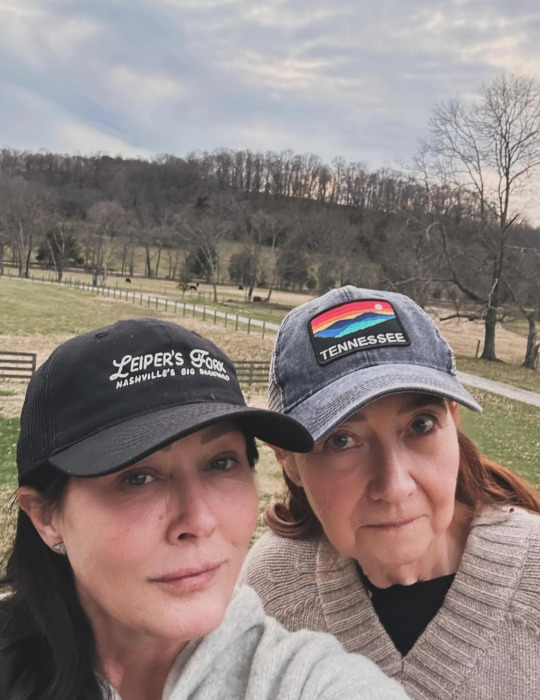
Shannen and her mum spending time in nature, ca.2024.
Shannen explained that she wasn't able to be with her dad when he passed away on the 4th of November of 2010. Her best friend Chris Cortazzo told her to spend some quality time with her mother and him at his ranch in Tennesse, which is surrounded by Native American ground. When she was there suddenly the wind shaked the plants and trees and she felt her father’s arms go around her and say “It’s ok baby, I love you. I’m here" (Source) (Source).
Her mother Rosa said that one of her great-great-grandmothers (she doesn't know the grade) was forced to move in the called "Trail of Tears", the forced displacement of approximately 60,000 people of the "Five Civilized Tribes" [Cherokee, Chickasaw, Choctaw, Muscogee (Creek), and Seminoles] between 1830 and 1850, and the additional thousands of Native Americans within that were ethnically cleansed by the United States government (Wiki). Furthermore, she said her ancestor was from the Chumash people and was forced to move from Mississipi to Oklahoma (Source).
Rosa also said about Shannen's Native American's heritage:
"The whole Indian heritage to Shannen was very, very important ... Shannen swore when she bought this property [a ranch in Malibu to live with her mum, her friends, and to do a shelter for horses]… she says, I just feel it. She says, I know that this is where I'm supposed to be. And she just felt that whole Indian."
Also she was proud of having directed "Charmed"'s episode "The Good, The Bad and The Cursed" that features a storyline involving American's First Nations people's and Native actors Kimberly Guerrero (from Colville and Salish-Kootenai native peoples from Alaska) and Michael Greyeyes (Nêhiyaw (Plains Cree) from Muskeg Lake Cree Nation in Saskatchewan, Canada).

Shannen Doherty (R) with First Nations' actors Kimberley Guerrero and Michael Greyeyes.
The Chumash are a Native American people of the central and southern coastal regions of California (Wiki), in portions of what is now Kern, San Luis Obispo, Santa Barbara, Ventura and Los Angeles counties, extending from Morro Bay in the north to Malibu in the south to Mt Pinos in the east. Their territory includes three of the Channel Islands: Santa Cruz, Santa Rosa, and San Miguel; the smaller island of Anacapa was likely inhabited seasonally due to the lack of a consistent water source.
Modern place names with Chumash origins include Malibu, Nipomo, Lompoc, Ojai, Pismo Beach, Point Mugu, Port Hueneme, Piru, Lake Castaic, Saticoy, Simi Valley and Somis. Archaeological research demonstrates that the Chumash people have deep roots in the Santa Barbara Channel area and lived along the southern California coast for millennia.
The Chumash lived in over 150 independent villages, speaking variations of the same language. Much of their culture consisted of basketry, bead manufacturing and trading, cuisine of local abalone and clam, herbalism which consisted of using local herbs to produce teas and medical reliefs, rock art, and the scorpion tree. The scorpion tree was significant to the Chumash as shown in its arborglyph: a carving depicting a six-legged creature with a headdress including a crown and two spheres. The shamans participated in the carving which was used in observations of the stars and in part of the Chumash calendar. The Chumash resided between the Santa Ynez Mountains and the California coasts where a bounty of resources could be found. The tribe lived in an area of three environments: the interior, the coast, and the Northern Channel Islands. Some researchers believe that the Chumash may have been visited by Polynesians between AD 400 and 800, nearly 1,000 years before Christopher Columbus reached the Americas.

Chumash Family by American sculptor George S. Stuart
The maritime explorer Juan Cabrillo was the first European to make contact with the coastal Alta Californian tribes in the year 1542. Spain claimed what is now California from that time forward, but did not return to settle until 1769, when the first Spanish soldiers and missionaries arrived with the double purpose of Christianizing the Native Americans and facilitating Spanish colonization. The Chumash people moved from their villages to the Franciscan missions between 1772 and 1817.
Mexico seized control of the missions in 1834. Tribespeople either fled into the interior, attempted farming for themselves and were driven off the land, or were enslaved by the new administrators. After 1849 most Chumash land was lost due to theft by Americans and a declining population, due to the effects of violence and disease. The remaining Chumash began to lose their cohesive identity. In 1855, a small piece of land (120 acres) was set aside for just over 100 remaining Chumash Indians near Santa Ynez mission. This land ultimately became the only Chumash reservation, although Chumash individuals and families also continued to live throughout their former territory in southern California.
No native Chumash speak their own language since Mary Yee, the last Barbareño speaker, died in 1965. Today, the Chumash are estimated to have a population of 5,000 members.
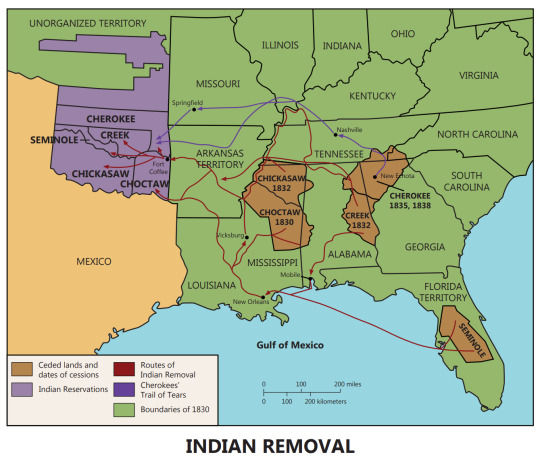
Map of the Trail of Tears
Chumash worldview is centered on the belief "that considers all things to be, in varying measure, alive, intelligent, dangerous, and sacred." "They assume that the universe with its three, or in some versions five, layers has always been here."
Human beings occupy the Middle Region, which rests upon two giant snakes. Chronological time is unimportant, though the past is divided into two sections: the universal flood that caused the First People to become the natural world and, thereafter the creation of human beings, the arrival of the Europeans, and the devastating consequences that followed."
The middle region (sometimes referred to as 'antap), where humans and spirits of this world live and where shamans could travel in vision quests, is interconnected with the lower world (C'oyinahsup) through the springs and marsh areas and is connected to the upper world through the mountains. In the lower world live snakes, frogs, salamanders. The world trembles or has earthquakes when the snakes which support the world writhe.
Water creatures are also in contact with the powers of the lower world and "were often depicted in rock art perhaps to bring more water to the Chumash or to appease underworld spirits' at times of hunger or disease." Itiashap is the home of the First People. Alapay is the upper world in Chumash cosmology where the "sky people" lived, who play an important role in the health of the people. Principle figures of the sky world include the Sun, the Moon, Lizard, Sky Coyote, and Eagle. The Sun is the source of life and is also "a source of disease and death." The Sky Coyote, also known as the Great Coyote of the Sky or Shnilemun, is considered to be a protector and according to Inseño Chumash lore, “looks out for the welfare of all in the world below him”. During the creation of mankind, the Sky Coyote was present among the other important cosmological figures. The Eagle, also known as Slo’w, is the force that maintains momentum and order among the other stars so that they do not fall down on and destroy earth.
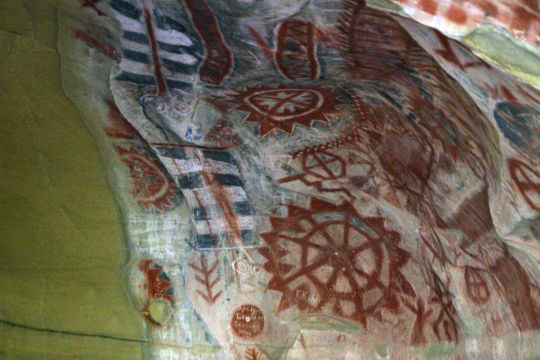
Chumash pictographs.
The Chumash cosmology is also centered around astronomy. Rock art and arborglyphs that have been found within Chumash sites are thought to have depicted Polaris (the North Star) and Ursa Major (the Big Dipper). These two astrological entities were paramount to the Chumash belief system as well as their perception of time. It is believed that the Chumash used these constellations to determine what time of the year it was depending on the position of Ursa Major around Polaris.
***
I love that Shannen showed her respect to her ancestry in some "Charmed" episodes, like in 2x10 "Heartbreak City" (click to see if bigger):

Charmed 3x01 "The Honeymoon is Over" (click to see bigger):

And the already mentioned 3x14 "The Good, The Bad and The Cursed" (click to see bigger). Her love for horses also comes from that connection:

#shannen doherty#ancestry#irish ancestry#native american ancestry#first nations ancestry#chumash#chumash people#family#trail of tears#heritage#indian heritage#charmed 3x14#charmed 2x10#charmed 3x01#charmed#director#shannen doherty director#shannen director#1990s shannen doherty#2000s shannen doherty#2020s shannen doherty#rosa doherty#malibu#chris cortazzo#tennesse
26 notes
·
View notes
Text
How it's done

This beautiful sculpture was built by the Irish people in their own country to honor the American Choctaw Indian tribe. They were grateful because in 1847 the Choctaw people sent money to Ireland when they learned that Irish people were starving due to the potato famine. The Choctaw themselves were living in hardship and poverty, having recently endured the Trail of Tears. And that is a lesson in how to be a person in this world. Kindred Spirits is a large stainless steel outdoor sculpture in Bailick Park in Midleton, County Cork, Ireland. The shape of the feathers is intended to represent a bowl of food.
- Native American DNA
61 notes
·
View notes
Text
It is on this day that we all observe International Holocaust Remembrance Day. The 27th of January.
But I want to take this occasion of remembering that genocide, to talk about another.
It was also on this day, exactly two centuries ago, that the Indian Territory was organized. It would be later be admitted to the Union of the United States under the name of "Oklahoma."
The Cherokee, Muscogee, Choctaw, Chickasaw, and Seminole, would all be forcefully deported from their homelands in the American Southeast, in what we call "The Trial of Tears."
60,000 people, over the course of twenty years, would be forced to walk over 1,200 miles, where about a fourth of them would perish in inhumane conditions.
#serious post#genocide#native american#native america#cherokee#muscogee#choctaw#chickasaw#seminole#indian territory#trail of tears#don't forget
11 notes
·
View notes
Text
J.D. Vance is even worse than you think.
[H]is worldview is fundamentally incompatible with the basic principles of American democracy. Vance has said that, had he been vice president in 2020, he would have carried out Trump’s scheme for the vice president to overturn the election results. He has fundraised for January 6 rioters. He once called on the Justice Department to open a criminal investigation into a Washington Post columnist who penned a critical piece about Trump. After last week’s assassination attempt on Trump, he attempted to whitewash his radicalism by blaming the shooting on Democrats’ rhetoric about democracy without an iota of evidence.
Being "evidence-free" is fairly normal for Republicans theses days, but let's continue.
This worldview translates into a very aggressive agenda for a second Trump presidency. In a podcast interview, Vance said that Trump should “fire every single mid-level bureaucrat” in the US government and “replace them with our people.” If the courts attempt to stop this, Vance says, Trump should simply ignore the law. “You stand before the country, like Andrew Jackson did, and say the chief justice has made his ruling, now let him enforce it,” he declares. The President Jackson quote is likely apocryphal, but the history is real. Vance is referring to an 1832 case, Worcester v. Georgia, in which the Supreme Court ruled that the US government needed to respect Native legal rights to land ownership. Jackson ignored the ruling, and continued a policy of allowing whites to take what belonged to Natives. The end result was the ethnic cleansing of about 60,000 Natives — an event we now call the Trail of Tears. For most Americans, this history is a deep source of shame: an authoritarian president trampling on the rule of law to commit atrocities. For Vance, it is a well of inspiration.
Implicitly, Vance favors the persecution of Native Americans. He's a fan of ethnic cleansing.
Vance apparently alters his views simply to further his ambitions.
Ultimately, whether Vance truly believes what he’s saying is secondary to the public persona he’s chosen to adopt. Politicians are not defined by their inner lives, but the decisions that they make in public — the ones that actually affect law and policy. Those choices are deeply shaped by the constituencies they depend on and the allies they court. And it is clear that Vance is deeply ensconced in the GOP’s growing “national conservative” faction, which pairs an inconsistent economic populism with an authoritarian commitment to crushing liberals in the culture war.
A favorite abbreviation of mine for "national conservative" is Nat-C.
Yes, Vance actually follows a monarchist blogger. What would the signers of the Declaration of Independence think?
Vance has cited Curtis Yarvin, a Silicon Valley monarchist blogger, as the source of his ideas about firing bureaucrats and defying the Supreme Court. His Senate campaign was funded by Vance’s former employer, Peter Thiel, a billionaire who once wrote that “I no longer believe that freedom and democracy are compatible.” He’s a big fan of Patrick Deneen, a Notre Dame professor who recently wrote a book calling for “regime change” in America. Vance spoke at an event for Deneen’s book in Washington, describing himself as a member of the “postliberal right” who sees his job in Congress as taking an “explicitly anti-regime” stance.
Those pushing the odious Project 2025, which we should think of as „Mein Trumpf“, are big fans of J.D..
Top Trump advisor (and current federal inmate) Steve Bannon told Ward that Vance is “at the nerve center of this movement.” Kevin Roberts, the president of the right-wing Heritage Foundation and the driving force behind Project 2025, told Ward that “he is absolutely going to be one of the leaders — if not the leader — of our movement.” He would be a direct conduit from the shadowy world of far-right influencers, where Curtis Yarvin is a respected voice and Viktor Orbán a role model, straight to 1600 Pennsylvania Avenue.
Viktor Orbán is not somebody any American leader should emulate. Orbán is essentially a goulash Putin.
In 2004, Democratic presidential candidate Howard Dean described himself as hailing from “the Democratic wing of the Democratic party.” If the GOP under Trump has indeed evolved into an authoritarian party, then Vance hails from its authoritarian wing.
So Vance is from the authoritarian wing of the authoritarian party.
Dictatorships are much easier to prevent than to remove. What are you doing in real life to work for the defeat of the Trump-Vance ticket? If you like democracy, you can't take it for granted.
NOTE: Zack Beauchamp who wrote the highlighted article above at Vox has a related book out this month.
#j.d. vance#vice presidential nominee#donald trump#republicans#the gop#authoritarianism#nat-c#project 2025#heritage foundation#native americans#trail of tears#curtis yarvin#peter thiel#steve bannon#viktor orbán#patrick deneen#zack beauchamp#election 2024#vote blue no matter who
19 notes
·
View notes
Text










1 OF 2
#decolonization#thanksgiving#settler colonialism#colonial genocide#genocide#weaponize illness#smallpox#wampanoag#national day of mourning#historical genocide#know your history#manifest destiny#turtle island#colonization of Palestine#apartheid#ethnic cleansing#chief pontiac#ghassan kanafani#nakba 1948#trail of tears#indian removal act#indigenous solidarity#cherokee nation#settler violence#stolen lives#stolen land#whitewashing genocide#forced displacement#indigenous refugees#polio
9 notes
·
View notes
Text



Crawford County, MO
4 notes
·
View notes
Text
#OTD in 1847 – Choctaw Indians collect money to donate to starving Irish Hunger victims.
Moved by news of starvation in Ireland, a group of Choctaws gathered in Scullyville, Ok, to raise a relief fund. Despite their meager resources, they collected $170 and forwarded it to a U.S. famine relief organisation. The Choctaw Indians may have seen echoes of their own fate in that of the Irish. Just 16 years before, in 1831, the Choctaw Indians were forcibly removed from their ancestral…

View On WordPress
#AnGortaMor#TheGreatHunger#TrailOfTears#&039;Kindred Spirits&039; Monument#America#An Gorta Mor#Bailic Park#Choctaw Indians#Co. Cork#Co. Mayo#England#Ireland#Midleton#Mississippi#Oklahoma#The Great Hunger#Trail of Tears
22 notes
·
View notes
Text
How To Erase a People
youtube
#indigenous#native American#Palestine#gaza#trail of tears#animisim#native american#native#isreal#america#usa#arab#arabic#Youtube
2 notes
·
View notes